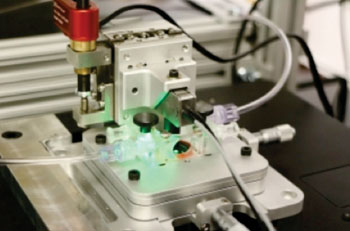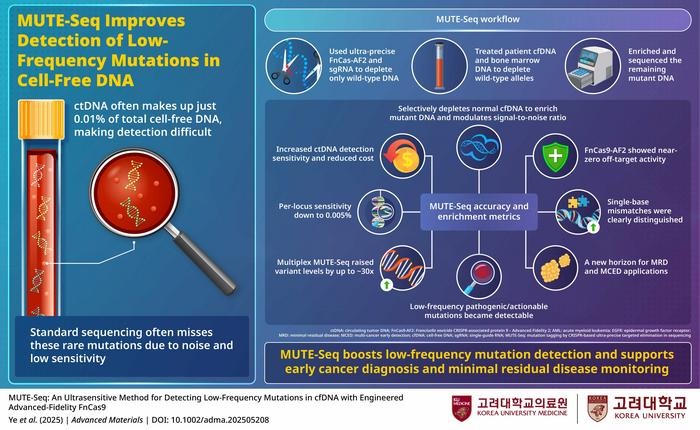Breakthrough DNA Analysis Technology to Hasten Problem Diagnosis
|
By LabMedica International staff writers Posted on 25 Aug 2014 |

Image: A technical breakthrough for DNA imaging has been achieved that should quicken diagnosis of diseases for which analysis of DNA from single-cells is critical, such as early stage cancers and various pre-natal conditions (Photo courtesy of McGill University and Génome Québec Innovation Center).
Researchers have achieved a technical breakthrough that should result in speedier diagnosis of diseases for which analysis of DNA from single-cells is critical, such as early stage cancers and various prenatal conditions.
The key discovery lies in a new tool developed by a team led by Sabrina Leslie and Walter Reisner, both professors of physics at McGill University (Montreal, QC, Canada), and their collaborator Dr. Rob Sladek of the McGill University & Génome Québec Innovation Center (MUGQ Innovation Center; Montreal, Quebec, Canada). The tool enables the loading of long strands of DNA into a tunable nanoscale imaging chamber in ways that maintain structural identity and conditions similar to their in vivo physiology. This breakthrough method – “Convex Lens-Induced Confinement” (CLIC) (also referred to as convex lens-induced nanoscale templating (CLINT)) – will permit a rapid imaging-based mapping of large genomes while simultaneously identifying specific gene sequences from single cells with single-molecule resolution, a process critical to diagnosing certain types of diseases.
Existing tools used for single-cell genomic analysis rely on side-loading DNA and under pressure into nanochannels in the imaging chamber, a practice that breaks the DNA molecules into small pieces, making it a challenge to later reconstruct the genome. The CLIC tool can be set on top of a standard inverted fluorescence microscope and its innovative aspect lies in the fact that it allows strands of DNA to be loaded into the imaging chamber – from above – and in a process that allows the strands of DNA to maintain their integrity.
“It’s like squeezing many soft spaghetti noodles into long narrow tubes without breaking them,” explains Prof. Leslie, “Once these long strands of DNA are gently squeezed down into nanochannels from a nanoscale bath above, they become effectively rigid which means that we can map positions along uniformly stretched strands of DNA, while holding them still. This means diagnostics can be performed quickly, one cell at a time, which is critical for diagnosing many prenatal conditions and the onset of cancer.”
“Current practices of genomic analysis typically require tens of thousands of cells worth of genomic material to obtain the information we need, but this new approach works with single cells,” said Dr. Sladek, “CLIC will allow researchers to avoid having to spend time stitching together maps of entire genomes as we do under current techniques, and promises to make genomic analysis a much simpler and more efficient process.”
“Nanoscale physics has so much to offer biomedicine and diagnostics,” added Prof. Leslie, “CLIC brings the nanoscale regime to the bench top, and genomics is just the beginning”.
The work was described by Berarda DJ et al. in the journal Proceedings of the National Academy of Sciences of the United States of America (PNAS), August 4, 2014, online ahead of print.
Related Links:
McGill University
The McGill University and Génome Québec Innovation Center
The key discovery lies in a new tool developed by a team led by Sabrina Leslie and Walter Reisner, both professors of physics at McGill University (Montreal, QC, Canada), and their collaborator Dr. Rob Sladek of the McGill University & Génome Québec Innovation Center (MUGQ Innovation Center; Montreal, Quebec, Canada). The tool enables the loading of long strands of DNA into a tunable nanoscale imaging chamber in ways that maintain structural identity and conditions similar to their in vivo physiology. This breakthrough method – “Convex Lens-Induced Confinement” (CLIC) (also referred to as convex lens-induced nanoscale templating (CLINT)) – will permit a rapid imaging-based mapping of large genomes while simultaneously identifying specific gene sequences from single cells with single-molecule resolution, a process critical to diagnosing certain types of diseases.
Existing tools used for single-cell genomic analysis rely on side-loading DNA and under pressure into nanochannels in the imaging chamber, a practice that breaks the DNA molecules into small pieces, making it a challenge to later reconstruct the genome. The CLIC tool can be set on top of a standard inverted fluorescence microscope and its innovative aspect lies in the fact that it allows strands of DNA to be loaded into the imaging chamber – from above – and in a process that allows the strands of DNA to maintain their integrity.
“It’s like squeezing many soft spaghetti noodles into long narrow tubes without breaking them,” explains Prof. Leslie, “Once these long strands of DNA are gently squeezed down into nanochannels from a nanoscale bath above, they become effectively rigid which means that we can map positions along uniformly stretched strands of DNA, while holding them still. This means diagnostics can be performed quickly, one cell at a time, which is critical for diagnosing many prenatal conditions and the onset of cancer.”
“Current practices of genomic analysis typically require tens of thousands of cells worth of genomic material to obtain the information we need, but this new approach works with single cells,” said Dr. Sladek, “CLIC will allow researchers to avoid having to spend time stitching together maps of entire genomes as we do under current techniques, and promises to make genomic analysis a much simpler and more efficient process.”
“Nanoscale physics has so much to offer biomedicine and diagnostics,” added Prof. Leslie, “CLIC brings the nanoscale regime to the bench top, and genomics is just the beginning”.
The work was described by Berarda DJ et al. in the journal Proceedings of the National Academy of Sciences of the United States of America (PNAS), August 4, 2014, online ahead of print.
Related Links:
McGill University
The McGill University and Génome Québec Innovation Center
Latest Technology News
- Machine Learning Models Diagnose ALS Earlier Through Blood Biomarkers
- Artificial Intelligence Model Could Accelerate Rare Disease Diagnosis
- AI Saliva Sensor Enables Early Detection of Head and Neck Cancer
- AI-Powered Biosensor Technology to Enable Breath Test for Lung Cancer Detection
- AI Model Achieves Breakthrough Accuracy in Ovarian Cancer Detection
- Portable Biosensor Diagnoses Psychiatric Disorders Using Saliva Samples
- Cell-Sorting Device Uses Electromagnetic Levitation to Precisely Direct Cell Movement

- Embedded GPU Platform Enables Rapid Blood Profiling for POC Diagnostics
- Viral Biosensor Test Simultaneously Detects Hepatitis and HIV
- Acoustofluidic Device to Transform Point-Of-Care sEV-Based Diagnostics
- AI Algorithm Assesses Progressive Decline in Kidney Function
Channels
Clinical Chemistry
view channel
Online Tool Detects Drug Exposure Directly from Patient Samples
Doctors often rely on patient interviews and medical records to determine what medications a person has taken, but this information is frequently incomplete. People may forget drugs they used, take over-the-counter... Read more
Chemical Imaging Probe Could Track and Treat Prostate Cancer
Prostate cancer remains a leading cause of illness and death among men, with many patients eventually developing resistance to standard hormone-blocking therapies. These drugs often lose effectiveness... Read moreMolecular Diagnostics
view channel
Ultrasensitive Method Detects Low-Frequency Cancer Mutations
Liquid biopsy has emerged as a promising approach for cancer detection and treatment monitoring, although its clinical impact has been limited by the extremely low levels of tumor-derived DNA circulating in blood.... Read more
Blood Test Enables Non-Invasive Endometriosis Detection
Endometriosis is a chronic, complex, yet relatively common gynecological disorder, reportedly affecting 1 in 10 adult and adolescent women. Endometriosis causes tissue similar to the lining of the uterus... Read moreHematology
view channel
MRD Tests Could Predict Survival in Leukemia Patients
Acute myeloid leukemia is an aggressive blood cancer that disrupts normal blood cell production and often relapses even after intensive treatment. Clinicians currently lack early, reliable markers to predict... Read more
Platelet Activity Blood Test in Middle Age Could Identify Early Alzheimer’s Risk
Early detection of Alzheimer’s disease remains one of the biggest unmet needs in neurology, particularly because the biological changes underlying the disorder begin decades before memory symptoms appear.... Read more
Microvesicles Measurement Could Detect Vascular Injury in Sickle Cell Disease Patients
Assessing disease severity in sickle cell disease (SCD) remains challenging, especially when trying to predict hemolysis, vascular injury, and risk of complications such as vaso-occlusive crises.... Read more
ADLM’s New Coagulation Testing Guidance to Improve Care for Patients on Blood Thinners
Direct oral anticoagulants (DOACs) are one of the most common types of blood thinners. Patients take them to prevent a host of complications that could arise from blood clotting, including stroke, deep... Read moreImmunology
view channel
Routine Blood Test Can Predict Who Benefits Most from CAR T-Cell Therapy
CAR T-cell therapy has transformed treatment for patients with relapsed or treatment-resistant non-Hodgkin lymphoma, but many patients eventually relapse despite an initial response. Clinicians currently... Read more
New Test Distinguishes Vaccine-Induced False Positives from Active HIV Infection
Since HIV was identified in 1983, more than 91 million people have contracted the virus, and over 44 million have died from related causes. Today, nearly 40 million individuals worldwide live with HIV-1,... Read more
Gene Signature Test Predicts Response to Key Breast Cancer Treatment
DK4/6 inhibitors paired with hormone therapy have become a cornerstone treatment for advanced HR+/HER2– breast cancer, slowing tumor growth by blocking key proteins that drive cell division.... Read more
Chip Captures Cancer Cells from Blood to Help Select Right Breast Cancer Treatment
Ductal carcinoma in situ (DCIS) accounts for about a quarter of all breast cancer cases and generally carries a good prognosis. This non-invasive form of the disease may or may not become life-threatening.... Read moreMicrobiology
view channel
Blood-Based Diagnostic Method Could Identify Pediatric LRTIs
Lower-respiratory tract infections (LRTIs) are a leading cause of illness and death worldwide, and pneumonia is the leading infectious cause of death in children under five, claiming the lives of over... Read more
Rapid Diagnostic Test Matches Gold Standard for Sepsis Detection
Sepsis kills 11 million people worldwide every year and generates massive healthcare costs. In the USA and Europe alone, sepsis accounts for USD 100 billion in annual hospitalization expenses.... Read moreRapid POC Tuberculosis Test Provides Results Within 15 Minutes
Tuberculosis remains one of the world’s deadliest infectious diseases, and reducing new cases depends on identifying individuals with latent infection before it progresses. Current diagnostic tools often... Read more
Rapid Assay Identifies Bloodstream Infection Pathogens Directly from Patient Samples
Bloodstream infections in sepsis progress quickly and demand rapid, precise diagnosis. Current blood-culture methods often take one to five days to identify the pathogen, leaving clinicians to treat blindly... Read morePathology
view channel
Rapid Low-Cost Tests Can Prevent Child Deaths from Contaminated Medicinal Syrups
Medicinal syrups contaminated with toxic chemicals have caused the deaths of hundreds of children worldwide, exposing a critical gap in how these products are tested before reaching patients.... Read more
Tumor Signals in Saliva and Blood Enable Non-Invasive Monitoring of Head and Neck Cancer
Head and neck cancers are among the most aggressive malignancies worldwide, with nearly 900,000 new cases diagnosed each year. Monitoring these cancers for recurrence or relapse typically relies on tissue... Read more
Common Health Issues Can Influence New Blood Tests for Alzheimer’s Disease
Blood-based tests for Alzheimer’s disease are transforming diagnosis by offering a simpler alternative to spinal taps and brain imaging. However, many people evaluated at memory clinics also live with... Read more
Blood Test Formula Identifies Chronic Liver Disease Patients with Higher Cancer Risk
Chronic liver disease affects millions worldwide and can progress silently to hepatocellular carcinoma (HCC), one of the deadliest cancers globally. While surveillance guidelines exist for patients with... Read moreIndustry
view channel
Abbott Acquires Cancer-Screening Company Exact Sciences
Abbott (Abbott Park, IL, USA) has entered into a definitive agreement to acquire Exact Sciences (Madison, WI, USA), enabling it to enter and lead in fast-growing cancer diagnostics segments.... Read more

















